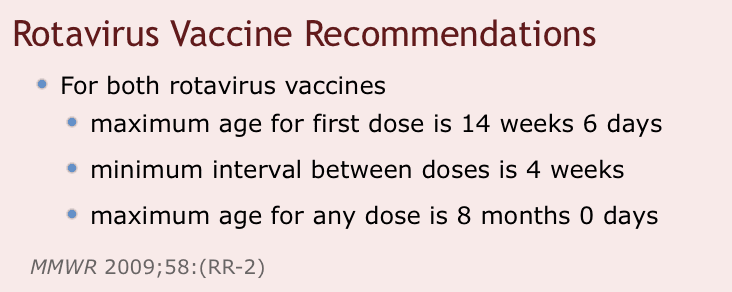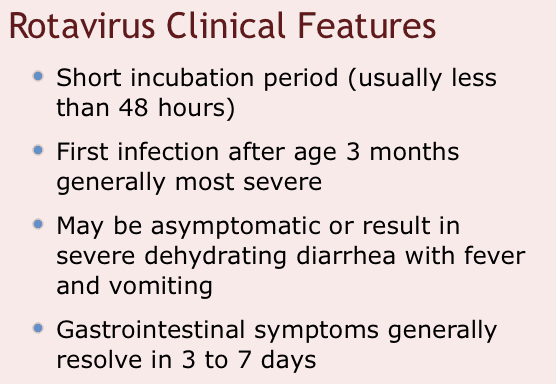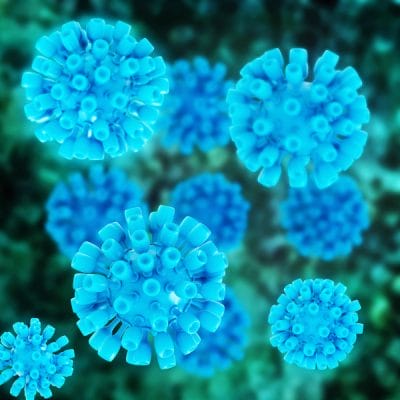- What is Rotavirus
- Rotavirus Symptoms
- Conventional Treatment for Rotavirus
- When is the Rotavirus Vaccine Given
- Efficacy of the Rotavirus Vaccine
- How Long Does Rotavirus Vaccine Protection Last
- Ingredients in the Rotavirus Vaccine
- Rotavirus Vaccine FDA Package Inserts
- Controversy and the Rotavirus Vaccine
- Rotavirus Vaccine Reactions
- The Bottom Line and the Rotavirus Vaccine
- Who Should Not Get the Rotavirus Vaccine
- References
- Resources
What is Rotavirus?
- Rotavirus is a virus that is transmitted by fecal-oral route: contact with saliva and stools of an infected individual.
- Symptoms of infection occur within 48 hours of exposure.
- Infant with rotavirus can remain contagious 1-3 weeks after symptoms begin.
- Rotavirus is the most common cause of severe diarrhea in children under 2 years of age, primarily among infants in daycare.
- By age 3, most children have come into contact with rotavirus and have built up some type of immunity against it.
- In the United States, rotavirus is most common in late fall and winter (there are several strains).
- Rotavirus vaccine was introduced in 2006.
- The clinical features and stool characteristics of rotavirus diarrhea are nonspecific, and similar illness may be caused by other pathogens. As a result, confirmation of a diarrheal illness as rotavirus requires laboratory testing. [1]
Infection may be asymptomatic, may cause self-limited watery diarrhea, or may result in severe dehydrating diarrhea with fever and vomiting. Up to one-third of infected children may have a temperature greater than 102°F (39°C). The gastrointestinal symptoms generally resolve in 3 to 7 days.
Rotavirus Symptoms
- Mild- severe diarrhea
- Dehydration
- Possible electrolyte imbalance
- Possible metabolic acidosis
- Symptoms vary among individuals. Breastfed infants generally have a mild case- loose stools a few times per day for 3-7 days, a few vomiting episodes, and possibly mild fever.
- Children who are immunocompromised because of congenital immunodeficiency more have more severe or prolonged disease. (the rotavirus vaccine is generally contraindicated in these individuals)
- Infants younger than 3 months of age may not show symptoms of rotavirus when infected due to maternal antibodies from mother. Breastfeeding also passes immunity to child.
When is the Rotavirus Vaccine Given?
The Rotavirus vaccine is given at 2 months, 4 months, and 6 months of age.
For more information:

Rotavirus vaccine has only been studied for efficacy/safety following the above schedule. http://www.cdc.gov/vaccines/pubs/pinkbook/rota.html
Conventional Treatment for Rotavirus
- For people with healthy immune systems, rotavirus infection of the bowel is a self-limited illness, lasting for only a few days. The treatment consists of increased fluid intake (oral rehydration) to prevent dehydration. [17]
- Hospitalization with IV fluids is not uncommon.
Efficacy of the Rotavirus Vaccine
- Any rotavirus gastroenteritis: 74-87% [1]
- Severe gastroenteritis: 85-98% effective [1]
How Long Does Rotavirus Vaccine Protection Last?
`The duration of immunity from rotavirus vaccine is not known. Efficacy through 2 rotavirus seasons has been studied for both vaccines. In general efficacy is lower in the second season than in the first. [1]
Ingredients in the Rotavirus Vaccine
The RotaTeq brand (Merck) contains:
- Five virus strains, live and whole
- Sucrose (a sugar)
- Sodium citrate, phosphate, and hydroxide
- Polysorbate 80
- Cell culture media (the gel or liquid that the viruses grow in; specific ingredients aren’t detailed)
- Traces of fetal cow blood (used to nourish the VERO cells)
- Vero cells [DNA from porcine circoviruses (PCV) 1 and 2 has been detected in RotaTeq. PCV-1 and PCV-2 are not known to cause disease in humans.] [14] See “Controversy and the Rotavirus Vaccine” below for further information
The Rotarix brand (GlaxoSmithKline) contains:
- Single virus strain, live and whole
- Sucrose (a sugar)
- Dextran Sorbitol (a sugar)
- Amino acids
- Dulbecco’s Modified Eagle Medium (a solution of vitamins, minerals, and phenol red)
- Calcium carbonate
- Xanthum gum
- Sterile water
- [Porcine circovirus type 1 (PCV-1) is present in Rotarix. PCV-1 is not known to cause disease in humans.] [14] – See “Controversy and the Rotavirus Vaccine” below for further information
Controversial Ingredients in the above vaccines:
- Monkey kidney cells
- Fetal cow blood
- Polysorbate 80
- Pig (porcine) virus contaminants
If you’d like specific information regarding each vaccine ingredient, including studies:
Rotavirus Vaccine FDA Package Inserts
- RV5 ROTARIX (GlaxoSmithKline) ROTARIX FDA Package Insert
- RV1 RotaTeq (Merck) RotaTeq FDA Package Insert
Controversy and the Rotavirus Vaccine
RotaTeq FDA Package Insert:
- In a post-marketing study, cases of intussusception were observed in temporal association within 21 days following the first dose of RotaTeq, with a clustering of cases in the first 7 days.
- No safety or efficacy data are available for the administration of RotaTeq to infants with a history of gastrointestinal disorders (e.g., active acute gastrointestinal illness, chronic diarrhea, failure to thrive, history of congenital abdominal disorders, and abdominal surgery).
- Vaccine virus transmission from vaccine recipient to non- vaccinated contacts has been reported. Caution is advised when considering whether to administer RotaTeq to individuals with immunodeficient contacts.
Below is a statement from the FDA in 2010 stating that pig viruses were found in both rotavirus vaccines, Rotarix and RotaTeq. There was a recommendation by the FDA to suspend the use of the vaccines until further review. On May 7, 2010, GlaxoSmithKline, the manufacturer of the Rotarix vaccine, pledged to remove the tainted porcine PCV1 DNA from the vaccine. On May 14, 2012, The FDA released a statement they have “no evidence that PCV1 or PCV2 pose a safety risk in humans, and neither is known to cause infection or illness in humans,” and the suspension of the vaccine was withdrawn. Today, both Rotarix and RotaTeq contain these pig viruses.
“On March 22, 2010, (if link is broken, go here) FDA provided an early communication regarding Rotarix, manufactured by GlaxoSmithKline Biologicals (GSK) At that time, FDA recommended that clinicians and public health professionals in the United States temporarily suspend the use of Rotarix while the agency and manufacturer investigated the finding of DNA from porcine circovirus type 1 (PCV1) in the vaccine. Since that time, both FDA and GSK have confirmed the presence of PCV1 in the vaccine.
On May 6, 2010 (if link is broken, go here) FDA provided information about RotaTeq, manufactured by Merck & Co, Inc. FDA indicated that preliminary studies conducted by Merck identified fragments of DNA from PCV1 and from a related porcine circovirus type 2 (PCV2) in RotaTeq. FDA noted that it would seek input from its Vaccines and Related Biological Products Advisory Committee (VRBPAC) and provide updates in the near future.
Updated Recommendations
FDA has evaluated laboratory results from the manufacturers and its own laboratories. In addition, FDA’s VRBPAC convened on May 7, 2010 (if link is broken, go here) to discuss the findings of PCV and PCV DNA in rotavirus vaccines. Based on a careful evaluation of this information, a thorough review of the scientific literature, and input from scientific and public health experts, the Agency is revising its recommendation to temporarily suspend use of the Rotarix vaccine. FDA has determined it is appropriate for clinicians and health care professionals to resume the use of Rotarix and to continue the use of RotaTeq.
FDA considered the following information in its decision:
- Both vaccines have strong safety records, including clinical trials involving tens of thousands of patients as well as clinical experience with millions of recipients. FDA has no evidence that either PCV1 or PCV2 poses a safety risk in humans, and notes that neither is known to cause infection or illness in humans.
- The FDA has no evidence that PCV1 or PCV2 pose a safety risk in humans, and neither is known to cause infection or illness in humans.
- The benefits of the vaccines are substantial, and include prevention of hospitalization for severe rotavirus disease in the U.S. and of death in other parts of the world. The benefits of the vaccines, which are known, outweigh the risk, which is theoretical.”
Rotavirus Vaccine Reactions
Rotarix Contraindications, Warnings and Precautions:
Rotarix FDA Package Insert (RotaTeq insert is similar):
CONTRAINDICATIONS:
- A demonstrated history of hypersensitivity to the vaccine or any component in the vaccine
- Gastrointestinal Tract Congenital Malformation
- History of Intussusception
- History of Severe Combined Immunodeficiency Disease
WARNINGS AND PRECAUTIONS:
- The tip caps of the prefilled oral applicators of diluent may contain natural rubber latex which may cause allergic reactions in latex-sensitive individuals.
- Administration of ROTARIX in infants suffering from acute diarrhea or vomiting should be delayed. Safety and effectiveness of ROTARIX in infants with chronic gastrointestinal disorders have not been evaluated.
- Safety and effectiveness of ROTARIX in infants with known primary or secondary immunodeficiencies have not been established.
- In a postmarketing study, cases of intussusception were observed in temporal association within 31 days following the first dose of ROTARIX, with a clustering of cases in the first 7 days
Study of of 70,000 infants:
Signs to look for include:
- Fever occurs in about 20 percent of infants
- Vomiting or diarrhea occurs in 10 percent
- Poor feeding in 25 percent
- Irritability was reported in 30 percent of infants
Known Severe Reactions:
- Seizures: 1 in 1,000 children
- Kawasaki disease: 1 in 10,000 children
- Intussusception: 1 in 51,000-68,000 to 1 in 100,000 (depending on which study you look review)
Postmarketing Surveillance:
(this means the adverse reactions that have been reported by the public since the introduction of the vaccine)
RotaTeq:
- Immune system disorders: Anaphylactic reaction
- Gastrointestinal disorders: Intussusception (including death), Hematochezia, Gastroenteritis with vaccine viral shedding in infants with Severe Combined Immunodeficiency Disease (SCID)
- Skin and subcutaneous tissue disorders: Urticaria, Angioedema
- Infections and infestations: Kawasaki disease, Transmission of vaccine virus strains from vaccine recipient to non-vaccinated contacts. [15]
Rotarix:
- In postmarketing experience, intussusception resulting in death following a second dose has been reported following a history of intussusception after the first dose.
- Gastrointestinal Disorders: Intussusception (including death), recurrent intussusception (including death), hematochezia, gastroenteritis with vaccine viral shedding in infants with Severe Combined Immunodeficiency Disease (SCID)
- Blood and Lymphatic System Disorders: Idiopathic thrombocytopenic purpura
- Vascular Disorders: Kawasaki disease
- General Disorders and Administration Site Conditions: Maladministration
The Bottom Line and the Rotavirus Vaccine
- In most cases, rotavirus is indistinguishable from other viruses known to cause diarrhea.
- By age 3, most children have been exposed to and developed antibodies against rotavirus strains.
- Infants who are breastfed and not in a childcare setting are at very low risk for catching rotavirus before one yr of age, when the virus can be more serious.
- Formula fed infants may be at higher risk for more serious side effects of rotavirus due to lack of breastfeeding maternal antibodies.
- Both rotavirus vaccines available contain pig viruses that were found in 2010. The FDA suspended the use of the vaccines, but then changed their mind stating the pig viruses “don’t seem to show infection of illness in humans.”
- In 1999, a highly efficacious rotavirus vaccine licensed in the United States, RotaShield, was withdrawn from the market after 14 months because of its association with intussusception. – CDC reference
- LA Times Article – “Anti-diarrheal Vaccine for Babies Recalled”
References
- Epidemiology and Prevention of Vaccine-Preventable Diseases, 12th Edition (The Pink Book)
(CDC) (web version)
- www.cdc.gov
- www.fda.gov
- What Your Doctor May Not Tell You About(TM) Children’s Vaccinations
- The Vaccine Book: Making the Right Decision for Your Child (Sears Parenting Library)
- Make an Informed Vaccine Decision for the Health of Your Child: A Parent’s Guide to Childhood Shots
- Vaccinations: A Thoughtful Parent’s Guide: How to Make Safe, Sensible Decisions about the Risks, Benefits, and Alternatives
- Vaccine Epidemic: How Corporate Greed, Biased Science, and Coercive Government Threaten Our Human Rights, Our Health, and Our Children
- How to Raise a Healthy Child in Spite of Your Doctor
- www.immunize.org
- drugs.com
- Federal Vaccine Compensation Statistics (US Department of Health and Human Services)
- Vaccine Ingredient Summary (CDC)
- Vaccine Excipient & Media Summary – Excipients Included in U.S. Vaccines, by Vaccine (updated 9/13)
- ROTARIX FDA Package Insert
- RotaTeq FDA Package Insert
- MedicineNet- Rotavirus
Resources
- CDC Rotavirus Vaccine Info
- World Health Organization (WHO) – Rotavirus
- Immunization Action Coalition – Rotavirus Vaccine Information Statement
- Ask Dr. Sears – Vaccines
- Vaccine Book List (with approximately 100 resource books)
- www.askdrsears.com
- World Health Organization (WHO)
- Center for Disease Control (CDC)
- www.livingwhole.org
- www.drtenpenny.com
- Vaccination Information Network
- www.vactruth.com
Back to Top
Reviewed/Updated: 09/14
Content Created: 05/14









